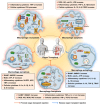Macrophage regulated cell death: implications and mechanisms in organ transplantation
- PMID: 40486507
- PMCID: PMC12140982
- DOI: 10.3389/fimmu.2025.1604429
Macrophage regulated cell death: implications and mechanisms in organ transplantation
Abstract
Organ transplantation is a critical treatment for end-stage organ failure, but long-term graft survival remains suboptimal due to ischemia-reperfusion injury (IRI) and transplant rejection. The immune microenvironment, especially macrophages, plays a key role in these processes. Various forms of regulated cell death (apoptosis, autophagy, pyroptosis, ferroptosis, necroptosis) in macrophages significantly influence transplant rejection by mediating cellular communication and shaping the immune microenvironment. Apoptosis, pyroptosis, ferroptosis and necroptosis in macrophages exacerbate graft rejection while autophagy in macrophages protects against transplant rejection by reducing inflammation.This paper reviews the specific molecular mechanisms of macrophage regulated cell death, their impact on the IRI and transplant rejection, thus further provide potential therapeutic target for improving transplant outcomes.
Keywords: ischemia-reperfusion injury; macrophage cell; organ transplantation; regulated cell death (RCD); transplant rejection.
Copyright © 2025 Hou, Li, Li, Yim, Geng, Cheng, Wang, Fan, Tong, Shi, Wang and Dong.
Conflict of interest statement
The authors declare that the research was conducted in the absence of any commercial or financial relationships that could be construed as a potential conflict of interest.
Figures
Similar articles
-
Cellular and molecular mechanisms of cell damage and cell death in ischemia-reperfusion injury in organ transplantation.Mol Biol Rep. 2024 Mar 29;51(1):473. doi: 10.1007/s11033-024-09261-7. Mol Biol Rep. 2024. PMID: 38553658 Free PMC article. Review.
-
M2 Macrophages Serve as Critical Executor of Innate Immunity in Chronic Allograft Rejection.Front Immunol. 2021 Mar 17;12:648539. doi: 10.3389/fimmu.2021.648539. eCollection 2021. Front Immunol. 2021. PMID: 33815407 Free PMC article. Review.
-
The innate immune response to allotransplants: mechanisms and therapeutic potentials.Cell Mol Immunol. 2019 Apr;16(4):350-356. doi: 10.1038/s41423-019-0216-2. Epub 2019 Feb 25. Cell Mol Immunol. 2019. PMID: 30804476 Free PMC article. Review.
-
[The role of regulated cell death in renal ischemia-reperfusion injury].Sheng Li Xue Bao. 2022 Apr 25;74(2):320-332. Sheng Li Xue Bao. 2022. PMID: 35503080 Review. Chinese.
-
Targeting Macrophages in Organ Transplantation: A Step Toward Personalized Medicine.Transplantation. 2024 Oct 1;108(10):2045-2056. doi: 10.1097/TP.0000000000004978. Epub 2024 Mar 12. Transplantation. 2024. PMID: 38467591 Review.
References
Publication types
MeSH terms
LinkOut - more resources
Full Text Sources
Medical


